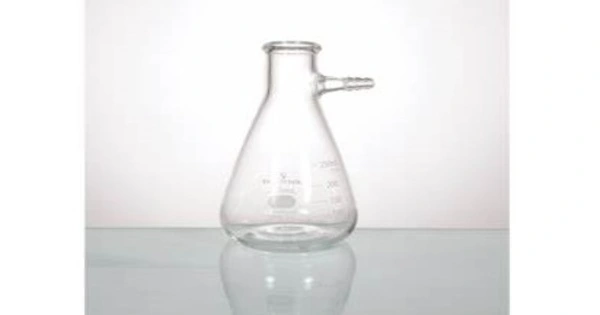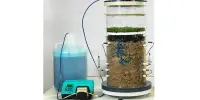A florentine flask, also known as a florentine receiver, a florentine separator, or an essencier (from French), as well as other shapes such as a florentine vase or a florentine vessel, is an oil-water separator that is fed with condensed vapors from a steam distillation in the fragrance extraction process.
It is a glass flask with a long neck and a spherical shape. It is designed for uniform heating and is available in a variety of glass thicknesses to suit different applications. It is typically made from borosilicate glass. It is a glass or metal receiver with an outlet at the top and another near the bottom for separating the layers of two immiscible distillates (such as oil and water in the steam distillation of essential oils).
Description
When the raw material is heated with steam from boiling water, volatile aromatic chemicals and steam exit the still. The condenser cools the vapours and converts them to liquid. The liquid enters the florentine receiver, and the water and essential oil phases separate. The essential oil phase separates from water because the oils have a distinct density and are not water-soluble.
There are two primary types of florentines in use. Essential oils with lesser density than water, such as lavender oil, accumulate in a layer that floats on the water. This type of florentine must be airtight to prevent the loss of volatile chemicals.
The other type is intended for oils that are denser than water, where the oil accumulates beneath the water phase, for instance cinnamon, wintergreen, vetiver, patchouli or cloves. The floating water phase avoids the loss of volatile compounds from the oil. There are also florentines that are able to accommodate oils that are denser or less dense than water.
The separated water is a herbal distillate that can be returned to the still or, in certain situations, sold as herbal water. Because little droplets of oil are entrained with the water that flows out of the florentine, employing many florentines in series can occasionally boost the output.
A little glass florentine without a base used in laboratories is referred to as a florentine vase because it resembles a small amphora. Larger glass receivers with bases are known as florentine flasks or essenciers. Glass is typically used in vessels up to 15 liters; beyond this size, glass is too fragile, hence metal is employed for higher capacities.
















